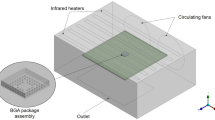Abstract
ANSYS simulation software has gold standard for modeling and simulating surface chemistry reactions that are used for the conceptual development of combustion systems in chemical and materials processing equipment. In this study, three different models of the solder bumps were arranged, designed, and simulated by ANSYS simulation software. The first model was a single solder bump, which had the height of 70 µm and diameter of 115 µm, and the both diameters to contact upper chip and lower substrates were 90 µm. The second model was that the single solder bumps were arranged to form an array with different spacing between two “single solder bumps”, the area and height were 1520 μm × 3610 μm and 70 μm. The third model was that the single solder bumps with two different arranged arrays were formed on the substrates on different sides, the distances between two “single solder bumps” had different values in the two arranged arrays, and the area and height for this model were 2600 μm × 2570 μm and 70 μm. We would use five differently underfill materials with different properties (including viscosity) as the simulated parameters in the third model. Finally, the five underfill materials were used in the dispensing experiment to find the optimum one for the flip chip packaging.











Similar content being viewed by others

References
ANSYS Acquires SpaceClaim Corporation (2016) A leading provider of 3-D modeling software. http://Otp.investis.com. Retrieved 27 Sept 2016
ANSYS Autodyn (2016) Equations of motion. http://Ansys.com. Retrieved 27 Sept 2016
Brand S, Vogg G, Petzold M (2017) Defect analysis using scanning acoustic microscopy for bonded microelectronic components with extended resolution and defect sensitivity. Microsyst Technol. doi:10.1007/s00542-017-3521-7
Ichikawa N, Hosokawa K, Maeda R (2004) Interface motion of capillary-driven flow in rectangular microchannel. J Colloid Interface Sci 280:155–164
Jong WR, Kuo TH, Ho SW, Chiu HH, Peng SH (2007) Flows in rectangular microchannels driven by capillary forces and gravity. Int Comm Heat Mass Transf 34:186–196
Kim YB, Sung J (2012) Capillary-driven micro flows for the underfill process in microelectronics packaging. J Mech Sci Technol 26:3751–3759
Lehmann G, Maria A, Lee PC, Cotts EJ (1997) Modeling the underfill flow process. In: Proceedings of technical program, conference on surface mount technology, San Jose, CA, USA, pp 340–350
Macosko CW (1994) Rheology: principles, measurements, and applications. VCH Publishers Inc, New York
Nguyen L, Quentin C, Fine P, Cobb B, Bayyuk S, Yang H, Bidstrup-Allen SA (1999) Underfill of flip chip on laminates: simulation and validation. IEEE Trans Compon Packag Technol 22:168–176
Nguyen ATT, Tjulkins F, Aasmundtveit KE, Hoivik N, Hoff L, Imene K (2015) Miniaturization of package for an implantable heart monitoring device. Microsyst Technol 21:1813–1826
Tummala RR (2001) Fundamentals of microsystems packaging. McGraw-Hill, Singapore
Wang J (2002) Underfill of flip chip on organic substrate: viscosity, surface tension, and contact angle. Microelectron Reliab 42:293–299
Wang H, Zhou H, Zhang Y, Li D, Xu K (2011) Three-dimensional simulation of underfill process in flip-chip encapsulation. Comput Fluids 44:187–2011
Yang C, Young WB (2013) The effective permeability of the underfill flow domain in flip-chip packaging. Appl Math Model 37:1177–1186
Young WB (2004) Capillary impregnation into cylinder banks. J Colloid Interface Sci 273:576–580
Young WB, Yang WL (2002) The effect of solder bump pitch on the underfill flow. IEEE Trans Adv Packag 25:537–542
Zhang ZQ, Wong CP (2009) Flip-chip underfill: materials, process, and reliability. In: Lu D, Wong CP (eds) Materials for advanced packaging. Springer, pp 307–338. doi:10.1007/978-0-387-78219-5
Acknowledgements
The authors would like to acknowledge the financial supports of the projects with the nos. of MOST 106-2221-E-390-019 and MOST 105-2622-E-390-003-CC3.
Author information
Authors and Affiliations
Corresponding author
Rights and permissions
About this article
Cite this article
Tsai, ST., Lin, CY., Wu, SM. et al. Analyses and statistics of the electrical fail for flip chip packaging by using ANSYS simulation software and really underfill materials. Microsyst Technol 24, 4017–4024 (2018). https://doi.org/10.1007/s00542-017-3605-4
Received:
Accepted:
Published:
Issue Date:
DOI: https://doi.org/10.1007/s00542-017-3605-4


